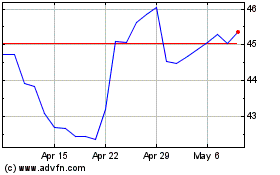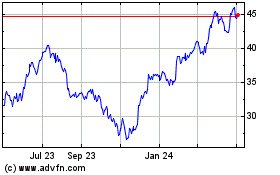Auto maker rejects investor proposal for dividend-paying shares
and a growth class
By David Benoit and Mike Colias
Investor David Einhorn is pressing General Motors Co. to create
two classes of common stock that would separate its dividend from
its operations, a novel proposal designed to invigorate a stock
that has languished despite rising sales and profits.
Mr. Einhorn, founder of hedge fund Greenlight Capital Inc., on
Tuesday publicly called on the auto maker to split its common stock
into two classes: one that pays dividends and a second that would
entitle its holders to all additional earnings.
His theory is that the two classes of stock would attract new
yield-hungry investors and those looking for growth. The increased
demand for the stocks, Mr. Einhorn said, could boost the auto
maker's $52 billion market capitalization by as much as $38
billion.
GM rejected the proposal, saying it "creates an unacceptable
level of risk," including the potential loss of its
investment-grade credit rating. It also cited "unknown and
uncertain market demand" for the proposed shares and raised
concerns about governance challenges that could arise from having
two groups of shareholders with competing interests.
GM shares rose 2.5% to $35.56 Tuesday, a sign that investors are
hopeful the campaign will produce gains in the stock.
Mr. Einhorn, a competitive poker player famous for his bearish
bet on Lehman Brothers Holdings Inc., has signaled he is willing to
fight, telling the company he may seek four seats on its board.
Greenlight has a 4.9% stake in GM, including options, according to
a Tuesday regulatory filing.
The campaign is another dilemma for a company that has grown
used to them. GM staved off a board fight with a group of hedge
funds two years ago with a $5 billion share buyback and emerged
from a government-sponsored trip through bankruptcy court in 2009.
Chief Executive Mary Barra has publicly wrestled with GM's stock
price, which has underperformed the S&P 500 since its 2010
return to the public markets.
The move has reignited a debate over whether a company's capital
structure influences its market value. Mr. Einhorn has privately
pushed similar dual-class structures at other companies in recent
years but hasn't yet found a taker, people familiar with the matter
said.
"If it makes the equities more attractive to investors, because
now they can have more choice, great," said James Angel, a finance
professor at Georgetown University. "Is it a panacea for low
valuation? I doubt it."
Ms. Barra and GM's board met with Greenlight several times over
the past seven months to discuss the idea. Two banks told the
company the plan wouldn't work, according to people familiar with
the matter. GM secretly consulted with a third bank, saying the
proposal was its idea, the people said. The outcome was the
same.
S&P Global Ratings and Moody's Investors Service on Tuesday
said the proposal, if implemented, could negatively affect GM's
credit rating.
"GM should not be guinea pig for this experiment," said a person
close to the auto maker who examined the proposal.
GM has benefited from a seven-year rise in U.S. auto sales since
the financial crisis, while low gasoline prices have fueled demand
for the company's high-margin pickup trucks and sports-utility
vehicles. It posted $12.5 billion in operating profit for last
year, its second straight record.
Yet, through Monday's close, the stock had risen just 5% from
its $33 initial public offering price in November 2010, a period
during with the S&P 500 more than doubled.
GM's price-to-earnings ratio, based on analyst forecasts for the
next year, ended Monday at 5.6, the cheapest among all stocks in
the S&P 500 and well below Ford Motor Co.'s 7.1. To catch up to
its rival on that front, GM's shares would need to rise about
25%.
Its dividend yield, meanwhile, is among the top 25 in the index.
The company pays an annual dividend of $1.52 a share.
Mr. Einhorn said he thinks the auto maker isn't getting credit
for its earnings potential or robust dividend. He said he believes
GM's management is doing a good job and isn't pushing it to change
its capital-spending plan, as other investors have done in the
past.
He estimates the dividend stock could trade at between $17 and
$22 and the remaining stock from $26 to $28, according to an
investor presentation made public Tuesday.
Mr. Einhorn has made a career pushing what he sees as
misunderstood stories on Wall Street. He argued that Lehman was
overvalued months before its collapse. He pushed Apple Inc. to
issue a dividend-paying preferred stock as a way to return more
capital to shareholders, dubbing it "iPref." The company rejected
the proposal but later implemented a $100 billion capital-return
plan.
An investor whose firm owns more than 800,000 GM shares said the
proposal "is not value-enhancing" and is happy with the actions GM
is taking to increase its value.
"You've got a stock that's a great value play at five times
earnings and a 5% yield," he said. "Why do this to distract a good
management team that has taken us back from the abyss?"
Ms. Barra has said she believes the market eventually will
reward the company for its improving performance. She has pressed
for improved products and cut costs while pursuing technologies
meant to reshape the car business, including its acquisition of
autonomous-driving startup Cruise Automation and an investment in
ride-hailing company Lyft Inc..
GM has said it has positioned the business to remain profitable
even if U.S. industry sales fall below 11 million light vehicles
from the 17.5 million sold last year. Most forecasts show sales
remaining in the 16 million to 17 million range for the next
several years.
Write to David Benoit at david.benoit@wsj.com and Mike Colias at
Mike.Colias@wsj.com
(END) Dow Jones Newswires
March 29, 2017 02:47 ET (06:47 GMT)
Copyright (c) 2017 Dow Jones & Company, Inc.
General Motors (NYSE:GM)
Historical Stock Chart
From Mar 2024 to Apr 2024

General Motors (NYSE:GM)
Historical Stock Chart
From Apr 2023 to Apr 2024
